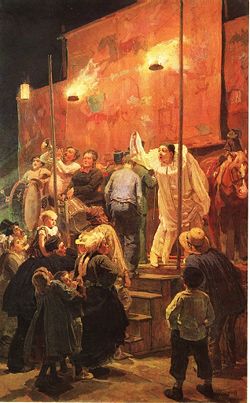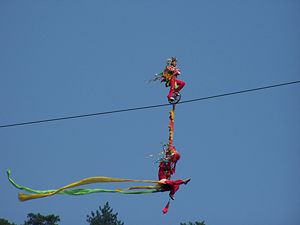Acrobatics
Acrobatics (from Greek Akros, high and bat, walking) while considered to be one of the performing arts, is also practiced competively as a sport. Acrobatic movements involve executing difficult feats of balance, agility and coordination often utilizing apparatus such as tightropes, trapezes, unicycles, balls, barrels, and/or poles. The performance of acrobatics requires quick reactions, accurate timing, and cool judgment. Acrobats have entertained and enthralled their audiences for thousands of years from the time of the Ancient Egyptians to the royal courts of the Middle Ages. Acrobats' daredevil antics and seemingly impossible contortions are crowd pleasers as everyone admires those who can challenge their physical limitations so successfully and fearlessly. Acrobats seem to defy death with their extreme balancing acts and reinforce our inner conviction that man is surely immortal.

Definition
Nearly any activity which involves full-body movement propelling an individual through air and space can be considered acrobatics. Acrobatics is a specialized activity that is incorporated into gymnastics, diving, and dance in the form of tumbling and other movements such as flips, somersaults, headstands, and handstands. The term "acrobatics" can also refer to "acrobatic gymnastics," a specialized subdivision of gymnastics which is a competitive sport in its own rght.
History
Western history
Acrobatic traditions can be found in many cultures throughout the world and throughout history. In the West, Minoan art from circa 2000 B.C.E. contains depictions of acrobatic feats on the backs of drawings of bulls. religious ritual.[1]
The court displays of the European Middle Ages would often involve acrobatic performances along with song, juggling and drama.
Acrobatics in Western history have been a popular subject for fine art. An excellent example would be Acrobats at the Cirque Fernando (Francisca and Angelina Wartenberg) by Impressionist Pierre-Auguste Renoir which depicts two German acrobatic sisters. The painting currently resides at the Art Institute of Chicago. David, could this image be added??? Eileen
Eastern history
In China, acrobatics (“Hundred Plays”) have been a part of the culture since the Western Han Dynasty, over 2500 years ago. Acrobatics were part of village harvest festivals.[2]
During the Tang Dynasty, acrobatics saw much the same sort of development as European acrobatics saw during the Middle Ages with court displays during the 7th through 10th century dominating the practice.[3] Today the performance art remains to be one of the most important performances offered within Chinese variety art, mostly referred to in the west as "Chinese Circus".
Chinese Acrobatics
Education
Traditionally, acrobatic skills were kept within families and passed from parents to children. This is still true especially among family circus groups nowadays. However, most acrobats are now taught by larger scale education systems, as circuses are now made up of many more professionals than they used to be. Many schools specializing in acrobatics art are providing a constant resource of acrobatic artists. Some of these schools are independently operated, and some are supported and affiliated to circuses.
Safety
Acrobatic Gymnastics
The first use of acrobatics as a specific sport was in the Soviet Union in the 1930s,[1] and the first world championships were in 1974.
Acrobatic Gymnastics are judged in five categories:
- Men’s pair
- Women’s pair
- Mixed pairs
- Women’s group (trio)
- Men's group (quadruples)
A sixth and seventh category for tumbling (men’s and women’s) were discontinued in the world championships in 1999. Many sports acrobatics groups continue to hold tumbling events, however.[4] Typically tumbling consists of three series of acrobatic elements performed on the run, including somersaults and handsprings.
The five types of event are choreographed with music. They can involve dance, tumbling and “partner skills” which can in turn involve “balance” and “dynamic” skills. Dynamic skills involve some form of aerial manoeuvre while balance skills involve poses and holds.
Sports acrobatics is the original and Acrobatic Gymnastics is now the official name for the sport, though it is known as Acro-gymnastics, Acro Gymnastics or Acrogymnastics as well.
In June 2006, four London Men became Acrobatic Gymnastic World Champions in the Mens Four.
There are a few acrobatic federations, including AFSA (acrobatics federation of South Africa).
Many dance studios hold acrobatics classes, and you can take shield or medal exams. [1]
Notes
- ↑ 1.0 1.1 Sports History - Acrobatics - Retrieved December 10, 2007.
- ↑ Red Panda Acrobats, San Francisco - History - Retrieved December 10, 2007.
- ↑ Acrobatic Art - Retrieved December 10, 2007.
- ↑ Irish Sports Acrobatics Homepage - Retrieved December 10, 2007.
ReferencesISBN links support NWE through referral fees
- Buchholtz, Stan. Balancing and Sport Acrobatics (1978). Arco Publishing ISBN 0668043962
- Polley, Maxine, Kent Austin, and Rick Takahashi. 1981. Acrobatics. Englewood Cliffs, N.J.: Prentice-Hall. ISBN 0130030791
- Smith, Morgan. 1982. An Introduction to Sports Acrobatics. London: S. Paul. ISBN 0091462304
- Wiley, Jack. 1978. Acrobatics Book. Mountain View, Calif: World Publications. ISBN 0890371415
External links
- History of Acrobatics Hickoksports.com.
- Acrobatics Dic.academic.ru.
- A Complete Guide on Acrobatics Hubpages.com.
- China Culture Chinaculture.org.
- Acrobatics leaps to new heights Chinadaily.com.cn.
- Cirque du Soleil Cirquedusoleil.com.
- Acrobats Agency Acrobatsagency.co.uk.
- Marcelo The Daredevil Marcelothedaredevil.com.
Credits
New World Encyclopedia writers and editors rewrote and completed the Wikipedia article in accordance with New World Encyclopedia standards. This article abides by terms of the Creative Commons CC-by-sa 3.0 License (CC-by-sa), which may be used and disseminated with proper attribution. Credit is due under the terms of this license that can reference both the New World Encyclopedia contributors and the selfless volunteer contributors of the Wikimedia Foundation. To cite this article click here for a list of acceptable citing formats.The history of earlier contributions by wikipedians is accessible to researchers here:
The history of this article since it was imported to New World Encyclopedia:
Note: Some restrictions may apply to use of individual images which are separately licensed.

